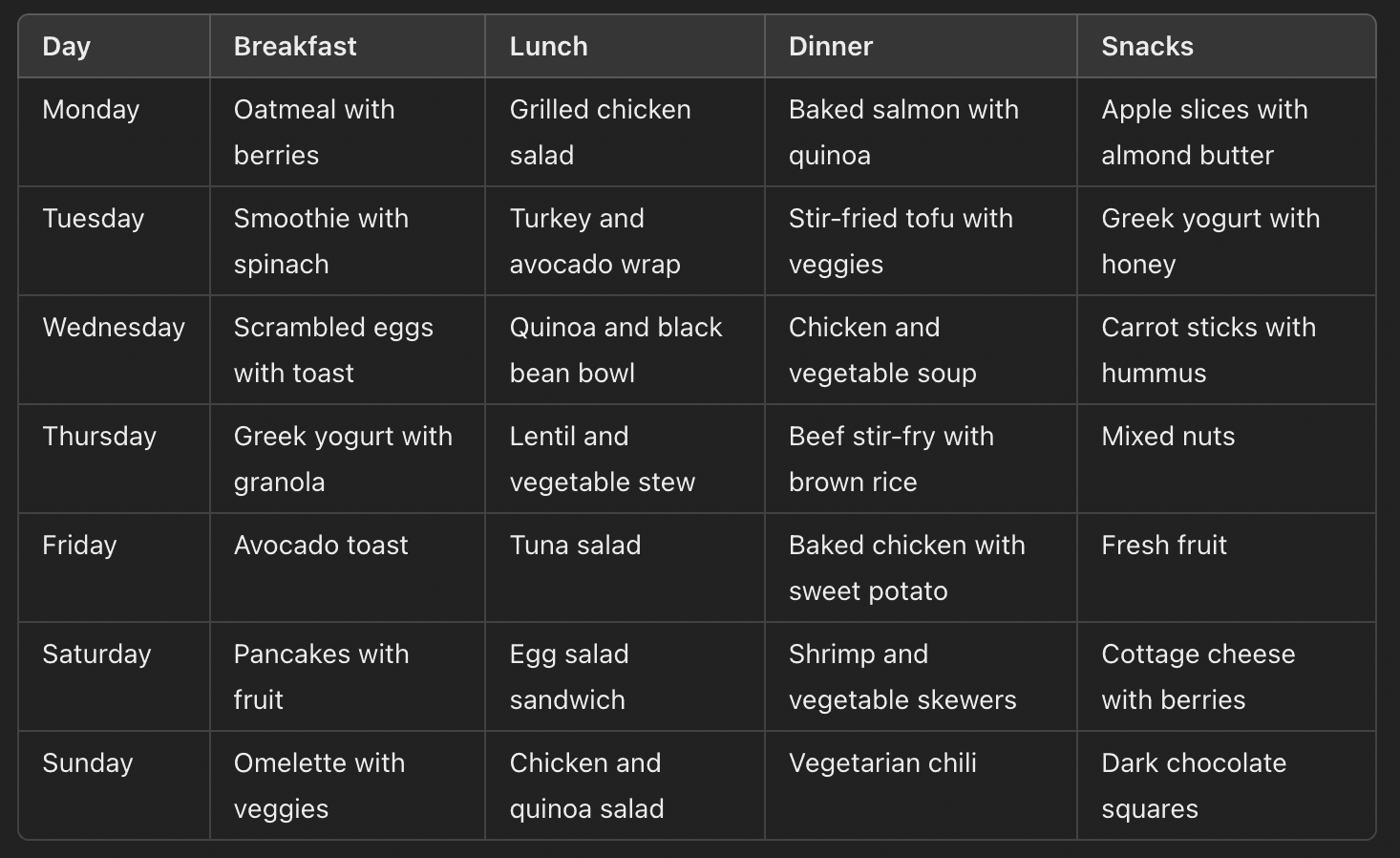Nutrition
Meal Plan Template: Simplify Nutrition and Health Goals
Discover how to create a meal plan template that simplifies nutrition. Ideal for fitness enthusiasts and anyone looking to improve their diet.
Jun 19, 2024



Introduction
Creating a meal plan template is an excellent way to organize your nutrition and ensure you meet your dietary goals. Whether you're a fitness enthusiast, a busy professional, or someone looking to improve their eating habits, a well-structured meal plan can simplify your life and enhance your health. This guide will help you understand the benefits of meal planning, how to create an effective template, and tips for sticking to your plan.
Introduction
Creating a meal plan template is an excellent way to organize your nutrition and ensure you meet your dietary goals. Whether you're a fitness enthusiast, a busy professional, or someone looking to improve their eating habits, a well-structured meal plan can simplify your life and enhance your health. This guide will help you understand the benefits of meal planning, how to create an effective template, and tips for sticking to your plan.
Understanding Meal Planning

Meal planning involves outlining your meals for a set period, usually a week. This proactive approach to eating helps you maintain a balanced diet, manage your time better, and avoid the stress of last-minute meal decisions.
Steps to Create a Meal Plan Template
1. Set Your Goals
Determine what you want to achieve with your meal plan. Whether it's weight loss, muscle gain, or simply eating healthier, having clear goals will guide your meal planning process.
Example Goals:
Weight loss
Muscle gain
Increased energy
Improved digestion
2. Assess Your Nutritional Needs
Understanding your nutritional requirements is crucial. Factors like age, gender, activity level, and dietary restrictions play a significant role.
Tools for Assessment:
Calorie calculators
Nutritional guides
Consultations with dietitians
3. Choose Your Meals
Plan your meals for the week, including breakfast, lunch, dinner, and snacks. Aim for a balance of macronutrients (proteins, carbohydrates, fats) and micronutrients (vitamins, minerals).
Example Breakdown:
Breakfast: High-protein options (e.g., eggs, Greek yogurt)
Lunch: Balanced meals with lean protein, veggies, and whole grains
Dinner: Lighter meals with a mix of protein and fiber
Snacks: Healthy options like fruits, nuts, and vegetables
4. Create a Shopping List
Based on your meal choices, list the ingredients you need. Organize the list by category (produce, dairy, pantry staples) to streamline your grocery shopping.
5. Prepare and Store Your Meals
Cook and store your meals in advance to save time during the week. Use airtight containers to keep food fresh and consider portioning meals for easy grab-and-go options.
Example Meal Plan Template

Tips for Sticking to Your Meal Plan

1. Be Flexible
Life can be unpredictable, so allow some flexibility in your meal plan. Swap meals if needed and adjust portions based on your hunger levels.
2. Incorporate Variety
Keep your meals interesting by rotating different recipes and ingredients. This prevents boredom and ensures a wider range of nutrients.
3. Stay Hydrated
Drinking plenty of water is crucial for overall health and can help manage hunger.
4. Monitor Your Progress
Track your adherence to the meal plan and its impact on your goals. Adjust the plan as needed based on your progress and feedback.
5. Involve Your Family
If cooking for a family, involve them in meal planning and preparation. This can make the process more enjoyable and inclusive.
Understanding Meal Planning

Meal planning involves outlining your meals for a set period, usually a week. This proactive approach to eating helps you maintain a balanced diet, manage your time better, and avoid the stress of last-minute meal decisions.
Steps to Create a Meal Plan Template
1. Set Your Goals
Determine what you want to achieve with your meal plan. Whether it's weight loss, muscle gain, or simply eating healthier, having clear goals will guide your meal planning process.
Example Goals:
Weight loss
Muscle gain
Increased energy
Improved digestion
2. Assess Your Nutritional Needs
Understanding your nutritional requirements is crucial. Factors like age, gender, activity level, and dietary restrictions play a significant role.
Tools for Assessment:
Calorie calculators
Nutritional guides
Consultations with dietitians
3. Choose Your Meals
Plan your meals for the week, including breakfast, lunch, dinner, and snacks. Aim for a balance of macronutrients (proteins, carbohydrates, fats) and micronutrients (vitamins, minerals).
Example Breakdown:
Breakfast: High-protein options (e.g., eggs, Greek yogurt)
Lunch: Balanced meals with lean protein, veggies, and whole grains
Dinner: Lighter meals with a mix of protein and fiber
Snacks: Healthy options like fruits, nuts, and vegetables
4. Create a Shopping List
Based on your meal choices, list the ingredients you need. Organize the list by category (produce, dairy, pantry staples) to streamline your grocery shopping.
5. Prepare and Store Your Meals
Cook and store your meals in advance to save time during the week. Use airtight containers to keep food fresh and consider portioning meals for easy grab-and-go options.
Example Meal Plan Template

Tips for Sticking to Your Meal Plan

1. Be Flexible
Life can be unpredictable, so allow some flexibility in your meal plan. Swap meals if needed and adjust portions based on your hunger levels.
2. Incorporate Variety
Keep your meals interesting by rotating different recipes and ingredients. This prevents boredom and ensures a wider range of nutrients.
3. Stay Hydrated
Drinking plenty of water is crucial for overall health and can help manage hunger.
4. Monitor Your Progress
Track your adherence to the meal plan and its impact on your goals. Adjust the plan as needed based on your progress and feedback.
5. Involve Your Family
If cooking for a family, involve them in meal planning and preparation. This can make the process more enjoyable and inclusive.

Your all-in-one fitness plan is just one click away
Try it free for 7 days. Cancel anytime.

Your all-in-one fitness plan is just one click away
Try it free for 7 days. Cancel anytime.

Your all-in-one fitness plan is just one click away
Try it free for 7 days.
Cancel anytime.
Conclusion
Creating a meal plan template is a practical and efficient way to manage your nutrition. By setting clear goals, understanding your nutritional needs, and planning your meals in advance, you can achieve your dietary objectives more effectively. Remember to be flexible, incorporate variety, and stay hydrated to maximize the benefits of your meal plan.
Ready to simplify your nutrition and achieve your health goals? Fit Senpai offers customized meal plans and workout routines tailored to your needs. Whether you're looking to lose weight, build muscle, or improve your overall health, our expert guidance will help you stay on track and reach your goals.
Visit Fit Senpai today and start your journey to better nutrition and fitness!
Conclusion
Creating a meal plan template is a practical and efficient way to manage your nutrition. By setting clear goals, understanding your nutritional needs, and planning your meals in advance, you can achieve your dietary objectives more effectively. Remember to be flexible, incorporate variety, and stay hydrated to maximize the benefits of your meal plan.
Ready to simplify your nutrition and achieve your health goals? Fit Senpai offers customized meal plans and workout routines tailored to your needs. Whether you're looking to lose weight, build muscle, or improve your overall health, our expert guidance will help you stay on track and reach your goals.
Visit Fit Senpai today and start your journey to better nutrition and fitness!
Conclusion
Creating a meal plan template is a practical and efficient way to manage your nutrition. By setting clear goals, understanding your nutritional needs, and planning your meals in advance, you can achieve your dietary objectives more effectively. Remember to be flexible, incorporate variety, and stay hydrated to maximize the benefits of your meal plan.
Ready to simplify your nutrition and achieve your health goals? Fit Senpai offers customized meal plans and workout routines tailored to your needs. Whether you're looking to lose weight, build muscle, or improve your overall health, our expert guidance will help you stay on track and reach your goals.
Visit Fit Senpai today and start your journey to better nutrition and fitness!
FAQ
What is a meal plan template?
A meal plan template is a structured outline of your meals for a set period, typically a week, designed to help you organize and manage your nutrition.How do I create a meal plan template?
Set your goals, assess your nutritional needs, choose your meals, create a shopping list, and prepare your meals in advance.Can a meal plan template help with weight loss?
Yes, a well-structured meal plan can help you control portion sizes, choose healthier foods, and stick to your dietary goals, aiding in weight loss.What should I include in a meal plan template?
Include balanced meals for breakfast, lunch, dinner, and snacks. Ensure a mix of proteins, carbohydrates, fats, and essential vitamins and minerals.How often should I update my meal plan template?
Update your meal plan template weekly or as needed based on your dietary goals and preferences.Can I customize a meal plan template for dietary restrictions?
Yes, tailor your meal plan to accommodate dietary restrictions such as gluten-free, vegetarian, vegan, or low-carb diets.How can I make meal prepping easier?
Prepare and store meals in advance, use airtight containers, and consider portioning meals for easy grab-and-go options.Is it necessary to follow the meal plan strictly?
While consistency is key, allow some flexibility to adjust meals based on your schedule and preferences.How do I ensure I'm getting enough nutrients with a meal plan template?
Plan balanced meals that include a variety of foods to ensure you get all essential nutrients. Consulting with a dietitian can also be helpful.Can a meal plan template save me money?
Yes, planning your meals can help you avoid unnecessary food purchases, reduce food waste, and save money.
FAQ
What is a meal plan template?
A meal plan template is a structured outline of your meals for a set period, typically a week, designed to help you organize and manage your nutrition.How do I create a meal plan template?
Set your goals, assess your nutritional needs, choose your meals, create a shopping list, and prepare your meals in advance.Can a meal plan template help with weight loss?
Yes, a well-structured meal plan can help you control portion sizes, choose healthier foods, and stick to your dietary goals, aiding in weight loss.What should I include in a meal plan template?
Include balanced meals for breakfast, lunch, dinner, and snacks. Ensure a mix of proteins, carbohydrates, fats, and essential vitamins and minerals.How often should I update my meal plan template?
Update your meal plan template weekly or as needed based on your dietary goals and preferences.Can I customize a meal plan template for dietary restrictions?
Yes, tailor your meal plan to accommodate dietary restrictions such as gluten-free, vegetarian, vegan, or low-carb diets.How can I make meal prepping easier?
Prepare and store meals in advance, use airtight containers, and consider portioning meals for easy grab-and-go options.Is it necessary to follow the meal plan strictly?
While consistency is key, allow some flexibility to adjust meals based on your schedule and preferences.How do I ensure I'm getting enough nutrients with a meal plan template?
Plan balanced meals that include a variety of foods to ensure you get all essential nutrients. Consulting with a dietitian can also be helpful.Can a meal plan template save me money?
Yes, planning your meals can help you avoid unnecessary food purchases, reduce food waste, and save money.
FAQ
What is a meal plan template?
A meal plan template is a structured outline of your meals for a set period, typically a week, designed to help you organize and manage your nutrition.How do I create a meal plan template?
Set your goals, assess your nutritional needs, choose your meals, create a shopping list, and prepare your meals in advance.Can a meal plan template help with weight loss?
Yes, a well-structured meal plan can help you control portion sizes, choose healthier foods, and stick to your dietary goals, aiding in weight loss.What should I include in a meal plan template?
Include balanced meals for breakfast, lunch, dinner, and snacks. Ensure a mix of proteins, carbohydrates, fats, and essential vitamins and minerals.How often should I update my meal plan template?
Update your meal plan template weekly or as needed based on your dietary goals and preferences.Can I customize a meal plan template for dietary restrictions?
Yes, tailor your meal plan to accommodate dietary restrictions such as gluten-free, vegetarian, vegan, or low-carb diets.How can I make meal prepping easier?
Prepare and store meals in advance, use airtight containers, and consider portioning meals for easy grab-and-go options.Is it necessary to follow the meal plan strictly?
While consistency is key, allow some flexibility to adjust meals based on your schedule and preferences.How do I ensure I'm getting enough nutrients with a meal plan template?
Plan balanced meals that include a variety of foods to ensure you get all essential nutrients. Consulting with a dietitian can also be helpful.Can a meal plan template save me money?
Yes, planning your meals can help you avoid unnecessary food purchases, reduce food waste, and save money.
You may also want to read this:
You may also want to read this:



Cheap & Easy 1800 Calorie Meal Plans
Get a simple 1,800-calorie meal plan with budget-friendly meals for weight loss, muscle gain, or maintenance. Includes portion sizes and meal ideas.



Best Meal Plan For Gestational Diabetes: Tips And Advice
Discover the best meal plan for managing gestational diabetes with our comprehensive guide. Get tips, meal ideas, and expert advice for a healthy pregnancy.



Best Meal Plan For Hypertension: Tips And Advice
Find the best meal plan for hypertension with heart-healthy foods, dietary tips, and lifestyle changes to help manage and lower blood pressure.
Your all-in-one fitness plan is just one click away
Try it free for 7 days. Cancel anytime.
Your all-in-one fitness plan is just one click away
Try it free for 7 days. Cancel anytime.
Your all-in-one fitness plan is just one click away
Try it free for 7 days. Cancel anytime.




